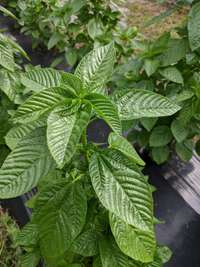This EDN issue features the ‘Thai’ variety of Corchorus olitorius or jute mallow. It is in the Malvaceae family which includes diverse species such as cotton (Gossypium hirsutum), cacao (Theobroma cacao), and okra (Abelmoschus esculentus). C. olitorius is best known as a fiber crop, commonly called burlap, and increasing in global demand (FAO, 2024). Additionally, people recognize it as a food crop in Africa and Asia.
General description

Figure 9. ‘Thai‘ jute mallow new growth. Source: Holly Sobetski
C. olitorius grows as an erect woody plant, 0.5 to 1.2 m (to 2.5 m under intense cultivation) with leaves up to 15 cm long (UN-EUE, 2001; Figure 9). Leaves are oval to elliptic, with serrated margins, yellow flowers with short, five-part seed capsules holding angular seeds. The ‘Thai’ variety is shorter, has more branching, and has more tender, smaller leaves compared to varieties used primarily for fiber. Use young and tender shoots and leaves for more palatability in eating.
Growing jute mallow
Agronomic recommendations for production are based on commercial growth of the related species (Corchorus capsularis) and, to a lesser extent, from using (C. olitorius) for fiber and food.
Jute mallow requires a warm and humid climate 16°C-40°C (24°C- 37°C as optimal), with farmers commercially growing it on alluvial soils during the normal rainy season with at least 500 mm of rainfall (NFSM, 2017). To ensure successful growth, farmers should till the soil well, maintain a pH of 5 to 8 (with 6.0 to 7.6 being optimal), and make sure it is well-aerated, not heavy textured or waterlogged (Pallvi, 2017).
For even distribution, mix seeds for broadcast with loose dry sand or a similar sized material, or plant them at a depth of 3-5 cm with 20 cm between rows and 10 cm between plants, with a seeding rate of 8 kg per ha for commercial production (Pallvi, 2017 ). Jute mallow is not demanding, responding to compost or low-levels of fertilizer. Commercial rates are 30-60 kg nitrogen ha-1 and 20-40 kg ha-1 for both phosphorus and potassium (Pallvi, 2017). Growing young plants in containers or spacing them wider in the field (opposed to fiber production) produces more palatable leaves for harvesting in as little as 30 days.
Pests
Stem rot (Macrophomina phaseolina) (Li et al., 2022) and the jute semi-looper (Anomis sabulifera), are economically important pests along with the hairy jute caterpillar (Spilosoma obliqua; Maity et al., 2012). Other than these pests, jute mallow is relatively free from pests and diseases while sharing minor pests with its close relative, cotton. These include a flea beetle (Podagrica sp.), cotton leaf roller (Sylepta sp.), cotton stainers (Dsysdercus sp.), and African grasshopper (Zonocerus sp.). Please consult your local extension services for pest identification and appropriate ecological control.
Food and nutrition
The ‘Thai’ variety produces more tender leaves and stems than more fibrous forms of jute mallow (C. capsularis). People cook and serve tender leaves and stems, like its relative okra for which jute mallow can serve as a replacement in recipes. Jute mallow has high levels of Beta-carotene, ascorbic acid, and calcium; and is a good source of folic acid, iron, and protein (AVRDC, 2009)
Medicinal
The antioxidant chemicals (e.g. ascorbic acid, thiols, and polyphenols) found in C. olitorius contribute to the treatment of a wide list of maladies that practitioners of natural medicine promote jute mallow for treating (Islam, 2013). There are more of these antioxidant chemicals present in the leaves, young stems, and mature roots during the flowering of jute mallow, and these are greater in C. olitorius than in C. capsularis (Abdel-Razek et al., 2022). Medicinal uses cited in the literature are wide ranging (Islam, 2013; Abdel-Razak et al., 2022; Biswas et al., 2023). Consult your local health professional for additional guidance.
ECHO’s Global Seed Bank has trial packets of ‘Thai’ jute mallow available to development workers (see the Global Seed Bank Page for how to request seeds).
References
Abdel-Razek, M.A.M., M.F. Abdelwahab, U.R. Abdelmohsen, and A.N.E. Hamed. 2022. Pharmacological and phytochemical biodiversity of Corchorus olitorius. RSC Adv. 12(54): 35103–35114.
AVRDC. 2009. Jute mallow. Discovering Indigenous Treasures: Promising Indigenous Vegetables from Around the World. World Vegetable Center. Taiwan. https://avrdc.org/jute-mallow-corchorus-olitorius/
Biswas, A., S. Dey, A. Xiao, S. Huang, Z.M. Birhanie, Y. Deng, L. Liu, and D. Li. 2023. Phytochemical content and antioxidant activity of different anatomical parts of Corchorus olitorius and C. capsularis during different phenological stages. Heliyon. Vol. 9, no. 6. https://doaj.org/article/1dfdfb60c76642239d23e747235774b5
Food and Agriculture Organization of the United Nations, (FAO). 2024. Future Fibers. https://www.fao.org/economic/futurefibres/fibres/jute/en/
Islam, M. 2013. Biochemistry, medicinal and food values of Jute (Corchorus capsularis L. and C. olitorius L.) leaf: a review. International Journal of Enhanced Research in Science Technology & Engineering, Vol. 2 (11)35-44.
Li D., F. Ahmed, N. Wu, and A.I. Sethi. 2022. YOLO-JD: A Deep Learning Network for Jute Diseases and Pests Detection from Images. Plants 11(7), 937. https://doi.org/10.3390/plants11070937
Maity, S., S. Chowdhury, and D. Animesh. 2012. Jute Biology, Diversity, Cultivation, Pest Control, Fiber Production and Genetics. In: Organic Fertilisation, Soil Quality and Human Health. 10.1007/978-94-007-4113-3_9.
(NFSM) (India). 2017. Jute: Brief note. National Food Security Mission. https://nfsm.gov.in/BriefNote/BN_Jute.pdf
Pallvi, G. 2017. Jute: Origin, Distribution and Production. Agriculture in India. https://www.agricultureinindia.net/agronomy/jute/jute-origin-distribution-and-production-essayagronomy/12517
UN-EUE (United Nations-Emergency Unit for Ethiopia). 2001. Famine Food Field Guide. Addis Ababa, Ethiopia. https://www.africa.upenn.edu/faminefood/category1/cat1_Oloqiloqota_ok.htm